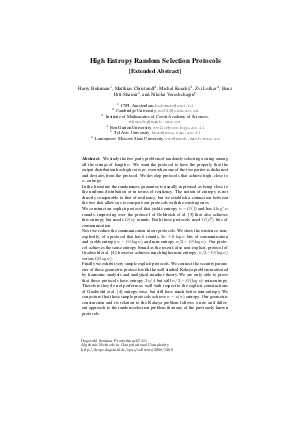High Entropy Random Selection Protocols
Authors Nikolai K. Vereshchagin, Harry Buhrman, Matthias Cristandl, Michal Koucky, Zvi Lotker, Boaz Patt-Shamir
-
Part of:
Volume:
Dagstuhl Seminar Proceedings, Volume 7411
Part of: Series: Dagstuhl Seminar Proceedings (DagSemProc) - License:
 Creative Commons Attribution 4.0 International license
Creative Commons Attribution 4.0 International license
- Publication Date: 2008-01-23
File

PDF
DagSemProc.07411.5.pdf
- Filesize: 198 kB
- 14 pages
Document Identifiers
Subject Classification
Keywords
- Shannon entropy
- Random string ds
Metrics
- Access Statistics
-
Total Accesses (updated on a weekly basis)
0Document
0Metadata
Abstract
We study the two party problem of randomly selecting a string among all the strings of length n. We want the protocol to have the property that the output distribution has high entropy, even when one of the two parties is dishonest and deviates from the protocol. We develop protocols that achieve high, close to n, entropy. In the literature the randomness guarantee is usually expressed as being close to the uniform distribution or in terms of resiliency. The notion of entropy is not directly comparable to that of resiliency, but we establish a connection between the two that allows us to compare our protocols with the existing ones. We construct an explicit protocol that yields entropy n - O(1) and has 4log^* n rounds, improving over the protocol of Goldwasser et al. that also achieves this entropy but needs O(n) rounds. Both these protocols need O(n^2) bits of communication. Next we reduce the communication in our protocols. We show the existence, non-explicitly, of a protocol that has 6-rounds, 2n + 8log n bits of communication and yields entropy n- O(log n) and min-entropy n/2 - O(log n). Our protocol achieves the same entropy bound as the recent, also non-explicit, protocol of Gradwohl et al., however achieves much higher min-entropy: n/2 - O(log n) versus O(log n). Finally we exhibit very simple explicit protocols. We connect the security parameter of these geometric protocols with the well studied Kakeya problem motivated by harmonic analysis and analytical number theory. We are only able to prove that these protocols have entropy 3n/4 but still n/2 - O(log n) min-entropy. Therefore they do not perform as well with respect to the explicit constructions of Gradwohl et al. entropy-wise, but still have much better min-entropy. We conjecture that these simple protocols achieve n -o(n) entropy. Our geometric construction and its relation to the Kakeya problem follows a new and different approach to the random selection problem than any of the previously known protocols.
Cite As Get BibTex
Nikolai K. Vereshchagin, Harry Buhrman, Matthias Cristandl, Michal Koucky, Zvi Lotker, and Boaz Patt-Shamir. High Entropy Random Selection Protocols. In Algebraic Methods in Computational Complexity. Dagstuhl Seminar Proceedings, Volume 7411, Schloss Dagstuhl – Leibniz-Zentrum für Informatik (2008)
https://doi.org/10.4230/DagSemProc.07411.5
BibTex
@InProceedings{vereshchagin_et_al:DagSemProc.07411.5,
author = {Vereshchagin, Nikolai K. and Buhrman, Harry and Cristandl, Matthias and Koucky, Michal and Lotker, Zvi and Patt-Shamir, Boaz},
title = {{High Entropy Random Selection Protocols}},
booktitle = {Algebraic Methods in Computational Complexity},
series = {Dagstuhl Seminar Proceedings (DagSemProc)},
ISSN = {1862-4405},
year = {2008},
volume = {7411},
editor = {Manindra Agrawal and Harry Buhrman and Lance Fortnow and Thomas Thierauf},
publisher = {Schloss Dagstuhl -- Leibniz-Zentrum f{\"u}r Informatik},
address = {Dagstuhl, Germany},
URL = {https://drops.dagstuhl.de/entities/document/10.4230/DagSemProc.07411.5},
URN = {urn:nbn:de:0030-drops-13091},
doi = {10.4230/DagSemProc.07411.5},
annote = {Keywords: Shannon entropy, Random string ds}
}
